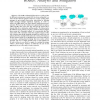SIGOPSE
2004
ACM
14 years 5 months ago
2004
ACM
Overlay networks are widely used to deploy functionality at edge nodes without changing network routers. Each node in an overlay network maintains pointers to a set of neighbor no...
CCS
2005
ACM
14 years 5 months ago
2005
ACM
Indirection-based overlay networks (IONs) are a promising approach for countering distributed denial of service (DDoS) attacks. Such mechanisms are based on the assumption that at...
INFOCOM
2005
IEEE
14 years 5 months ago
2005
IEEE
— Recently, overlay networks have emerged as a means to enhance end-to-end application performance and availability. Overlay networks attempt to leverage the inherent redundancy ...
ICDCS
2007
IEEE
14 years 6 months ago
2007
IEEE
Application-layer overlay networks have recently emerged as a promising solution for live media multicast on the Internet. A tree is probably the most natural structure for a mult...
ICDCS
2007
IEEE
14 years 6 months ago
2007
IEEE
Abstract— Overlay routing has emerged as a promising approach to improving performance and reliability of Internet paths. To fully realize the potential of overlay routing under ...
GLOBECOM
2007
IEEE
14 years 6 months ago
2007
IEEE
— The traffic exchanged between two overlay nodes in different autonomous systems (AS) is always subjected to a series of inter-domain policies. However, overlay routing often m...
ACNS
2008
Springer
14 years 6 months ago
2008
Springer
Peer-to-Peer (P2P) overlay networks are a flexible way of creating decentralized services. Although resilient to external Denial of Service attacks, overlay networks can be render...
DSN
2009
IEEE
14 years 7 months ago
2009
IEEE
Topological worms, such as those that propagate by following links in an overlay network, have the potential to spread faster than traditional random scanning worms because they h...



